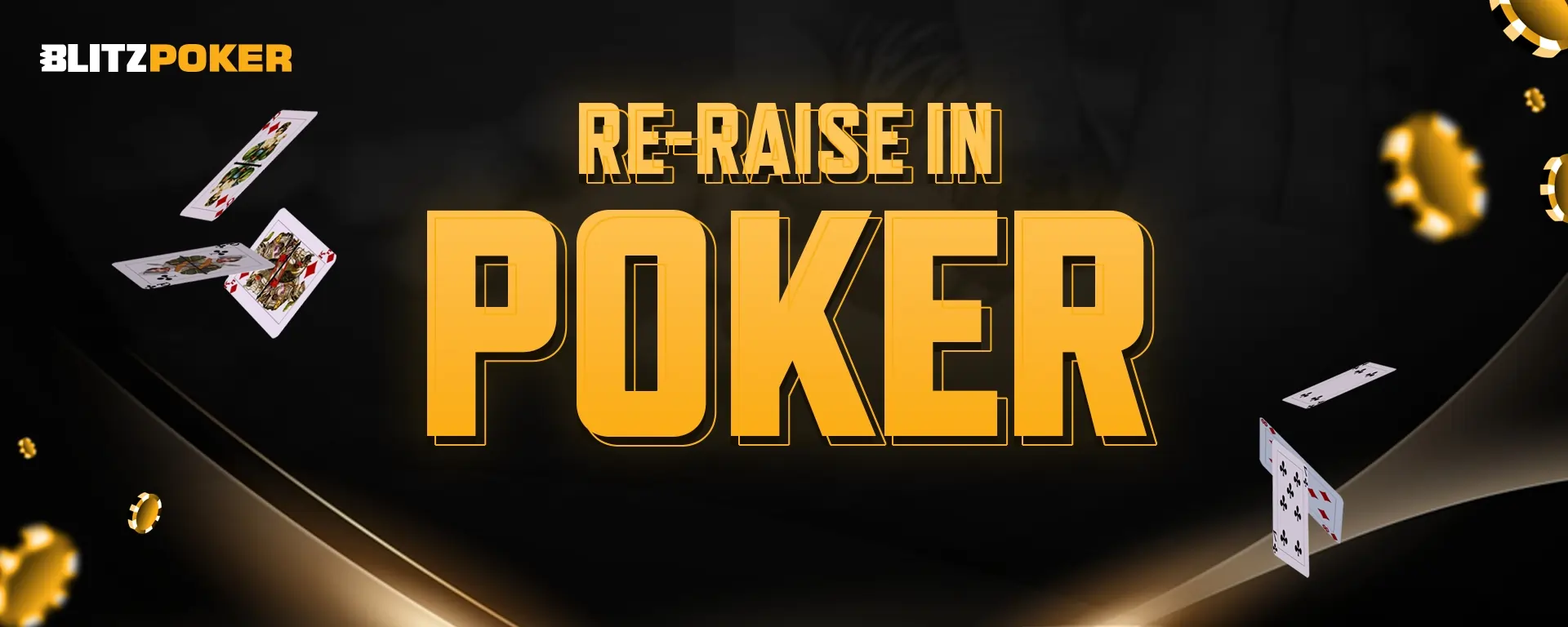Re-raise in Poker
In poker, raising is a bold move that shows strength and grows the pot. But reraising takes it to the next level, demonstrating unwavering confidence and a near-unbeatable hand. It’s a high-stakes play that demands skill and strategy but yields big rewards when executed perfectly. When you re-raise in poker, you not only increase the bet – but you also make a statement. You tell your opponents that you’re a force to be reckoned with, and you’re not afraid to take risks. It’s a play that demands confidence, skill, and a keen sense of timing. Ready to put your reraising skills to the test? Join BLITZPOKER, the ultimate online poker platform in India and get ready to blitz your way to victory!
Re-raise Meaning
Re-raising in poker means making another raise during a single betting round after someone has already raised. When you re-raise, you increase the stakes, forcing your opponents to reconsider their hands. It’s a powerful tactic that can win you the pot or make other players fold. Knowing when and how to re-raise effectively is a crucial skill in poker, as it can significantly impact the outcome of the game.
When To Re-raise?
Ideally, you should consider re-rasing in the following scenarios:
- When you have a very strong hand and want your opponents to call.
- When you think a re-raise will make your opponent fold.
- When calling would leave you with a small, awkward stack.
In Texas Hold’em, most re-raises take place during the preflop betting round. The first player who bets more than the big blind amount preflop is said to be raising. Any action that increases the bet beyond that is called re-raising.
For example, in a Texas Hold’em cash game at ₹2/₹3 stakes, the under-the-gun player limps (calls for ₹3). The player in the cutoff raises to ₹15.
If the player on the button makes it ₹60 to go, that’s a re-raise. The first re-raise in the preflop betting round is called a three-bet. If a player raises against a three-bet, it’s a four-bet. Re-raising against a four-bet is a five-bet, and so on.
While most three-betting happens preflop, the same terms apply to postflop re-raises. Re-raising after the flop usually means you have a very strong hand or a strong draw.
How Much Should You Re-raise in Poker?
Before the flop, three-bets usually range from 3x to 5x the initial raise. Many experts prefer a three-bet size of around 3x when they have a good position, and about 4x when they are out of position.
Experienced players often four-bet preflop at 2x to 3x the opponent’s three-bet. Again, out-of-position four-bets should be larger than those in position.
Postflop re-raises can vary a lot, especially in live cash games. A good guideline is to re-raise to about 3x your opponent’s raise.
Poker rules state that the minimum re-raise size must be at least the amount of the previous raise. For example, if your opponent bets ₹1,600 on the flop, any re-raise must be at least ₹1,600 more, or ₹3,200 in total.
Re-raise in Poker Rules
Understanding how to raise and re-raise in poker is key. Here’s what you need to know:
- Minimum Raise in No Limit Games: In No Limit, your raise must at least match the previous raise size. Example: If someone bets 3bb, the next raise must be at least 5bb, not necessarily double.
- Pot-Sized Raise in Pot-Limit Games: Calculating a pot-sized raise can be tricky. It’s about matching the total pot size after your call. Example: If ₹10 is in the pot and someone bets ₹5, raising would mean totalling ₹25 after your raise.
- When Re-raising is Limited: Re-raising isn’t always allowed, especially if someone goes all-in for less than the minimum raise size. Example: If a player bets ₹10 and another goes all-in for ₹18, re-raising might not be an option.
- Limit Game Cap: In limit games, there’s a cap on the number of raises per round, often set at four. Example: Player A bets₹2, Player B raises to ₹4, and so on, up to the cap limit.
- Understanding “Cap Poker”: “Cap poker” sets a maximum stack size per hand, usually around 40 big blinds. Once reached, further raises are off the table.
How to Deal with Re-Raises in Poker?
1) Standard Game
- Opponent’s Likely Range: Strong hands like AA, KK, QQ, JJ, AK, sometimes AQ and TT.
- Strategy:
- Fold speculative hands.
- Call with pocket pairs (9s, 10s, Jacks).
- Reraise with Aces and Kings.
- Call or reraise with Ace-King and Queens, preferring to reraise AK to see all community cards and possibly force folds from better pairs.
2) Tight Game
- Opponent’s Likely Range: Only the very strongest hands (AA, KK).
- Strategy:
- Fold most hands unless they min-raise.
- Only continue if you hit a very strong hand on the flop (two pair or better).
- Recognise that tight opponents rarely reraise with weak hands.
3) Wild Game
- Opponent’s Likely Range: Wide range including AA, KK, QQ, JJ, AK, AQ, TT, sometimes AJ suited and 99.
- Strategy:
- 3bet more aggressively if they single-raise wide.
- Ensure you have a large stack for effective post-flop play.
- Four-bet if you believe they are reraising light and you have enough chips.
- Call with lighter holdings if you have room to manoeuvre post-flop.
- With less than 100 big blinds, consider going all-in preflop with tens and AQ.
- Make bluff-reraises with hands like King-Ten to scoop pots and force folds.
